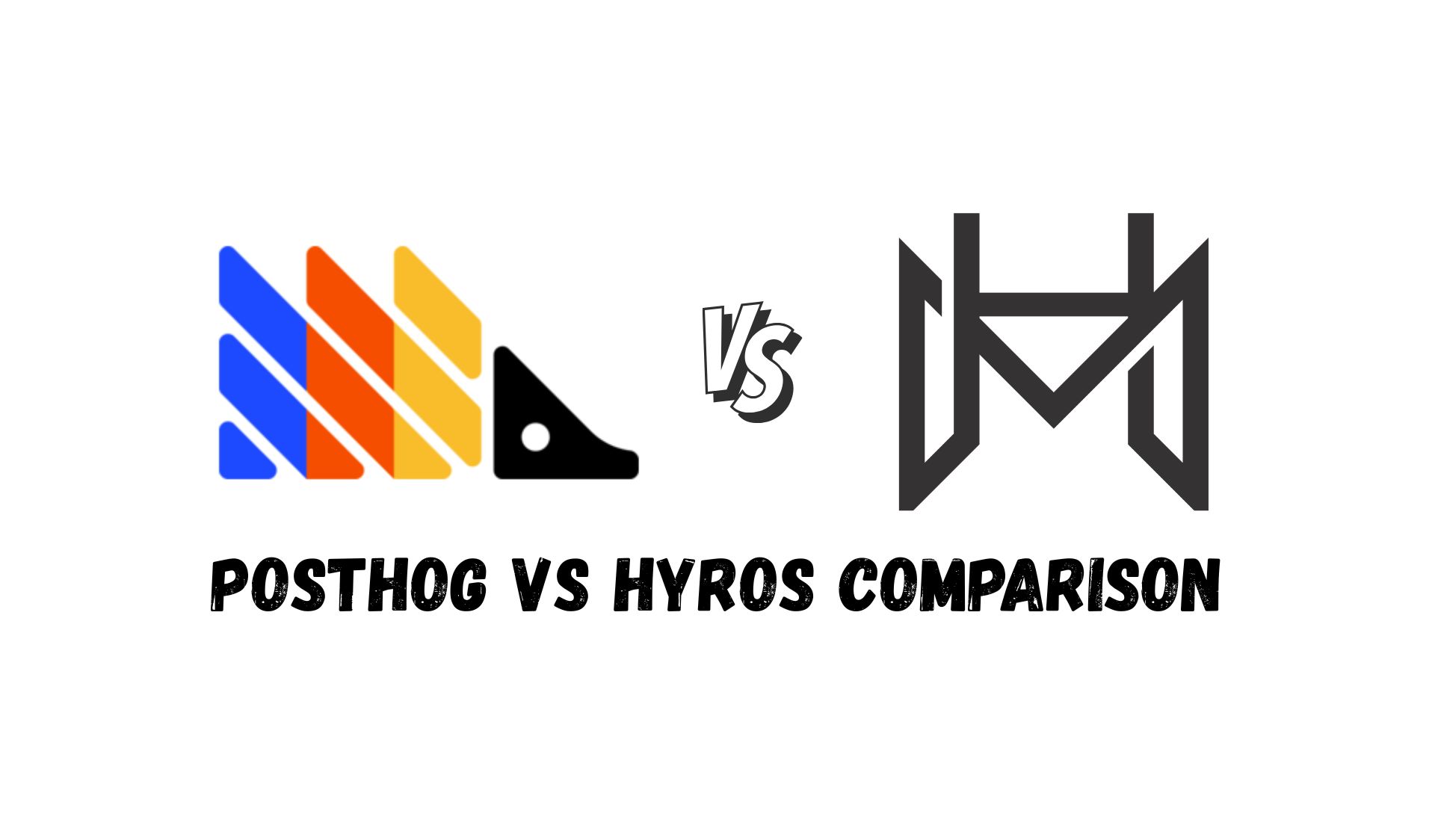
In the world of data-driven growth, two tools often enter the conversation when teams are trying to track, attribute, and optimize performance: PostHog and Hyros.
On the surface, they may look like they belong to the same category. They both give you insights. They both help you understand your users or customers. But under the hood? They couldn’t be more different.
Let’s dive in.
What Is PostHog?
PostHog is an open-source product analytics platform designed for product teams and developers. It captures user behavior, tracks events, supports feature flagging, session replays, A/B testing, and even feedback surveys; all under one roof.
Think of PostHog as a Swiss army knife for product-led growth teams. It’s like Mixpanel, FullStory, Google Analytics, and Hotjar got together and decided to build one unified, privacy-compliant platform that works out of the box.
Quick PostHog snapshot:
- Tracks frontend and backend events (no black boxes)
- Offers self-hosting for privacy-conscious teams
- Built for technical users (engineers love it)
- Includes feature flags, session replay, A/B testing, heatmaps, and more
It’s the tool you reach for when you want complete control over your analytics stack and you want it to scale with your product.
What Is Hyros?
Hyros, on the other hand, is a premium ad attribution and tracking platform built for marketers; especially those managing large paid traffic budgets. Its core superpower? Telling you exactly which ads, funnels, emails, and calls led to a sale.
And it does this across multiple channels: Facebook, Google, YouTube, TikTok, native, email, and even phone.
While PostHog gives you deep behavioral insight, Hyros gives you money insight: What ad made you the most profit? What keyword led to your high-ticket sale? It’s designed for entrepreneurs and marketers who are obsessed with return on ad spend (ROAS).
Quick Hyros snapshot:
- AI-powered attribution for long and complex funnels
- Tracks ads, email, SMS, calls, and more
- Helps optimize media buying decisions
- Used heavily in info products, eComm, coaching, SaaS, and agencies
If you’ve ever looked at your Facebook Ads Manager and screamed, “Why are my ROAS numbers so off?!”, Hyros might just be your new best friend.
PostHog vs Hyros Comparison: Key Differences
| Feature | PostHog | Hyros |
|---|---|---|
| Primary Focus | Product analytics, feature flags, experimentation | Ad attribution, ROAS optimization |
| Audience | Product teams, engineers, growth marketers | Media buyers, entrepreneurs, agency owners |
| Hosting | Self-hosted or cloud | Cloud only |
| Pricing | Generous free tier + pay-as-you-go | Starts around $500/month |
| Tracking Style | Event-based analytics | Customer journey + revenue attribution |
| Session Replay | ✅ Built-in | ❌ Not available |
| A/B Testing | ✅ Native feature | ❌ Not supported |
| Privacy Control | High (self-hosting, GDPR-compliant) | Medium |
| Attribution Depth | Basic (UTMs, referrers, campaigns) | Advanced (AI-based, cross-channel, phone/email/ads) |
PostHog Pros and Cons
Pros:
- All-in-one tool for analytics, experiments, feedback, and growth
- Free to get started, very affordable at scale
- Extensive & granular reporting and filtering options
- Flexible and highly customizable (engineer-first design)
- One of, if not the best, A/B testing tools on the market. (Yes, we always use PostHog)
- Full control over your data (great for EU companies and startups with compliance needs)
Cons:
- Requires technical setup (dev resources needed for full implementation)
- Limited focus on paid traffic attribution
- Not ideal for solo marketers or non-technical teams
Hyros Pros and Cons
Pros:
- Industry-leading attribution accuracy (especially for complex, multi-touch journeys)
- Easy to use for non-technical teams
- High quality & easy event reporting to ad platforms with Conversion API
- Tracks email, phone, funnels, and ad platforms effortlessly
- Clear, money-based insights (what’s driving revenue)
- Especially valuable for high-ticket funnels and ads-heavy businesses
Cons:
- Expensive for small businesses or early-stage startups
- Not meant for product analytics or behavior tracking
- No self-hosted option (may not suit privacy-sensitive orgs)
When to Use Which?
Choose PostHog if:
- You’re building a product, app, or SaaS platform and want to understand user behavior
- You need event tracking, session replays, and funnel analysis
- Your team is technical and wants control
- You want to A/B test features or roll out releases gradually
Example: You’re a startup founder who wants to know exactly who came to your website, where they came from, and what they did.
Choose Hyros if:
- You’re running Facebook, Google, or YouTube ads and want true attribution
- You sell high-ticket products or run complex sales funnels (think VSLs, webinars, DMs, calls)
- You manage ad spend and need to double down on what converts
- You want to know exactly which ad creatives are printing cash
Example: You’re a marketing team leader who wants to have accurate profit-based reporting on every single campaign and ad. You also want to increase the quality of the event you’re optimizing for to improve your ROAS.
Common Misconceptions
“Hyros is better than PostHog.” Not true. they solve completely different problems. PostHog is about product, Hyros is about marketing. Comparing them directly without understanding your needs will lead to frustration.
“PostHog can’t do attribution.” Not entirely true. While it doesn’t specialize in ad attribution, PostHog can handle source tracking via UTM parameters and custom events. For product-led attribution, it’s more than capable.
“You only need one” In reality, advanced businesses often use both. PostHog for product growth; Hyros for marketing spend optimization.
From Chaos to Clarity
A SaaS company running paid ads and experimenting with new features was flying blind. Their Facebook attribution was wildly inconsistent, and they had no idea how users behaved after signup.
They implemented both:
- PostHog gave them behavior insights: Which onboarding screens worked, which didn’t.
- Hyros showed them their real cost per acquisition (CPA), cutting wasted ad spend by 30%.
This combo turned a leaky bucket into a laser-focused growth machine.
FAQ
Is PostHog free?
Yes. It has a free tier that includes up to 1 million events and 5,000 session recordings per month. Paid plans scale based on usage.
Is Hyros worth the price?
For marketers spending over $10k/month on ads, many say yes. It provides granular ROAS insights that free tools can’t match. They also claim that you get back three times your money’s worth by simply implementing Hyros and increasing your event quality scores.
Can I self-host Hyros?
No. Hyros is a closed SaaS platform with no open-source or self-hosting options.
Can I use PostHog for ad tracking?
To some extent, yes. You can track UTMs and first-party cookies, but you won’t get multi-channel attribution or revenue tie-ins like you would with Hyros.
Should I use PostHog self-hosted or cloud?
If you’re in a privacy-heavy field like healthcare or finance, self-hosting is your best bet, it keeps all your data in-house. For everyone else, the cloud version is quicker, easier, and fully managed, so you can focus on insights instead of infrastructure.
Does Hyros replace Google Analytics or PostHog?
Not exactly. Hyros specializes in tracking ad-driven conversions and improving ROAS. PostHog is more of a product analytics and event tracking tool. Many companies use them alongside GA or other analytics tools.
Can I integrate Hyros with PostHog?
Direct integration isn’t offered, but you can connect them indirectly using tools like Zapier or custom webhooks to sync event and revenue data.
Does Hyros work for organic traffic?
Hyros focuses mostly on paid traffic attribution. While you can track some organic leads, its value is maximized for businesses with significant ad spend.
How to Decide
- Audit your goals. Are you focused on product adoption or ad ROI?
- Evaluate your team. Do you have developers who can set up PostHog?
- Consider your budget. PostHog is affordable; Hyros is premium.
- Look at your funnel. Is it complex? Multi-channel? That’s where Hyros shines.
- Map your data needs. Do you need deep user behavior or just conversions?
Final Thoughts: Two Tools, Two Mindsets
In this article, there’s no “one size fits all” answer; only what fits your strategy, your budget, and your business model.
- PostHog is like a microscope for product teams; see what users do, test ideas, grow smarter.
- Hyros is like a GPS for ad spend; track every dollar, double down on what works.
The real magic happens when you align your tools with your goals.
So… what are you trying to grow?
If you’re a product-focused startup or scaling SaaS, give PostHog a spin. If you’re managing hefty ad budgets and struggling with attribution nightmares, Hyros might pay for itself in days.
Need help implementing or deciding between the two? Reach out and book a consultation call through the ‘Let’s chat‘ button! we’ve worked with both, and we can guide you based on your specific setup.
Resources
- PostHog Documentation
- Hyros Knowledge Base
- How to Set Up A/B Testing on [WordPress, Shopify] in PostHog
- Hyros vs Facebook Attribution – Real Ad Buyer Case Study

